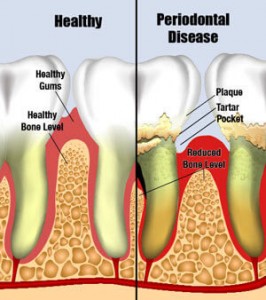Gum diseases, also referred to as periodontal diseases, are usually caused by a build-up of bacteria and plaque that inflames and infects the gums. Plaque may be a clear film on the teeth to which bacteria sticks, and if it isn’t removed with brushing and flossing, it’ll become a tough material called tartar. Tartar and bacteria deposits around and under the gum line are the most causes of periodontal diseases.
There are two sorts of periodontal disease: gingivitis and periodontitis.
• Gingivitis may be a milder sort of gum disease, during which gums become red, swollen, and should bleed easily.
• Periodontitis may be a far more serious oral health condition during which the inflammation spreads deep below the gum line and involves the bone and tissues that hold teeth in situ . Periodontitis can cause deep pockets of infection, which can end in the loss of teeth and their surrounding bone if it’s left untreated.
Fortunately, there are several procedures available to treat these oral health problems, counting on the severity of the disease.
The primary goal of any treatment for periodontitis is to regulate and eliminate the tartar and bacterial infection round the teeth and under the gums. Treatments range from deep cleanings to oral surgery.
Prevention of Periodontal Disease
The best ways to stop gingivitis from graduating to periodontitis are to:
• Brush your teeth after every meal.
• Floss a minimum of once each day .
• Eat a diet .
• Avoid tobacco products.
• Get regular dental checkups and cleanings.

- Home
- About Us
- Services
- Dental Lifestyle
- Wedding Smiles
- Gallery
- Contact Us
+91 1724648877
+91 9015455577
Clinic Timings
Mon - Sat - 9.30 AM to 2.00 PM
4.00 PM to 7.00 PM
Sunday By Prior Appointment
+91 9015455577
Clinic Timings
Mon - Sat - 9.30 AM to 2.00 PM
4.00 PM to 7.00 PM
Sunday By Prior Appointment



